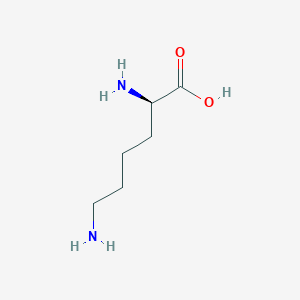| General Information of MET (ID: META00518) |
| Name |
D-Lysine
|
| Synonyms |
Click to Show/Hide Synonyms of This Metabolite
(R)-2,6-Diaminohexanoate; (R)-2,6-Diaminohexanoic acid; D-2,6-Diaminohexanoate; D-2,6-Diaminohexanoic acid; D-Lysin; DLY
|
| Source |
Aliphatic acyclic compounds
|
| Structure Type |
Amino acids, peptides, and analogues (Click to Show/Hide the Complete Structure Type Hierarchy)
Organic acids and derivatives
Carboxylic acids and derivatives
Amino acids, peptides, and analogues
|
| PubChem CID |
|
| HMDB ID |
|
| Formula |
C6H14N2O2
|
| Structure |
<iframe style="width: 300px; height: 300px;" frameborder="0" src="https://embed.molview.org/v1/?mode=balls&cid=57449"></iframe>
|
 |
|
3D MOL
|
2D MOL
|
|
Click to Show/Hide the Molecular/Functional Data (External Links/Property/Function) of This Metabolite
|
| KEGG ID |
|
| DrugBank ID |
|
| ChEBI ID |
|
| FooDB ID |
|
| Physicochemical Properties |
Molecular Weight |
146.19 |
Topological Polar Surface Area |
89.3 |
| XlogP |
-3 |
Complexity |
106 |
| Heavy Atom Count |
10 |
Rotatable Bond Count |
5 |
| Hydrogen Bond Donor Count |
3 |
Hydrogen Bond Acceptor Count |
4 |
| Function |
D-Lysine is an essential amino acid. It is often added to animal feed.
|
|
Regulatory Network
|
|
|
|
|
|
|
|
|
 click to show the details of this protein
click to show the details of this protein
 click to show the details of experiment for validating this pair
click to show the details of experiment for validating this pair

